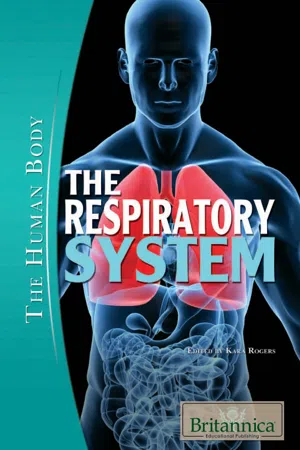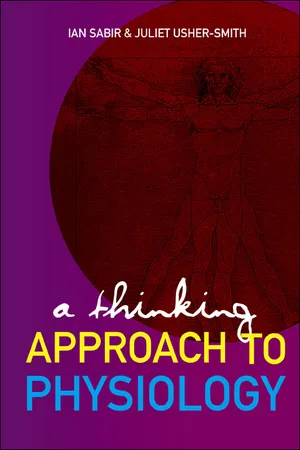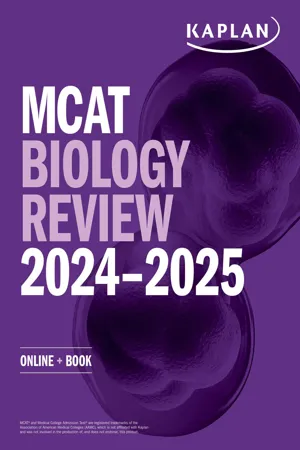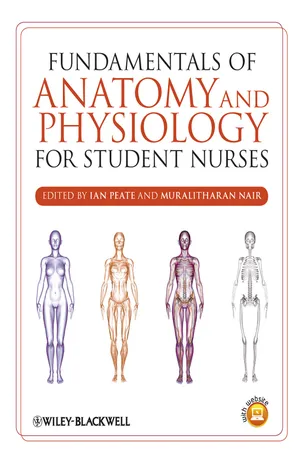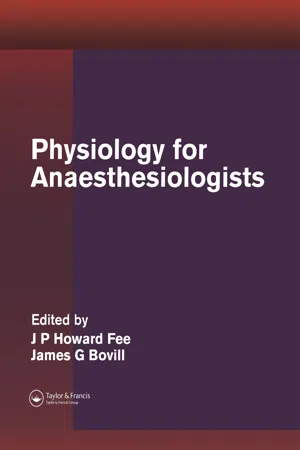Biological Sciences
Human Gas Exchange
Human gas exchange refers to the process by which the body takes in oxygen and expels carbon dioxide. This occurs in the lungs, where oxygen from inhaled air diffuses into the bloodstream and carbon dioxide from the blood is released into the air to be exhaled. The exchange is facilitated by the alveoli, tiny air sacs in the lungs.
Written by Perlego with AI-assistance
Related key terms
Related key terms
1 of 4
Related key terms
1 of 3
5 Key excerpts on "Human Gas Exchange"
- eBook - ePub
- Britannica Educational Publishing, Kara Rogers(Authors)
- 2010(Publication Date)
- Britannica Educational Publishing(Publisher)
AS EXCHANGE AND RESPIRATORY ADAPTATIONI nhaled air is rich in oxygen, which is needed to support the functions of the body’s various tissues. For inhaled oxygen to reach these tissues, however, it must first undergo a process of gas exchange that occurs at the level of the alveoli in the lungs. Blood vessels that pass alongside the alveoli membranes absorb the oxygen and, in exchange, transfer carbon dioxide to the alveoli. The oxygen is then distributed by the blood to the tissues, whereas the carbon dioxide is expelled from the alveoli during exhalation. At high altitudes or during activities such as deep-sea diving, the respiratory system, as well as other organ systems, adapt to variations in atmospheric pressure. This process of adaptation is necessary to maintain normal physiological function.GAS EXCHANGE
Respiratory gases—oxygen and carbon dioxide—move between the air and the blood across the respiratory exchange surfaces in the lungs. The structure of the human lung provides an immense internal surface that facilitates gas exchange between the alveoli and the blood in the pulmonary capillaries. The area of the alveolar surface in the adult human is about 160 square metres (1,722 square feet). Gas exchange across the membranous barrier between the alveoli and capillaries is enhanced by the thin nature of the membrane, about 0.5 micrometre, or 1/100 of the diameter of a human hair.Changes in the atmosphere’s pressure occur when deep-sea diving and require the respiratory system to adapt . Shutterstock.comRespiratory gases move between the environment and the respiring tissues by two principal mechanisms, convection and diffusion. Convection, or mass flow, is responsible for movement of air from the environment into the lungs and for movement of blood between the lungs and the tissues. Respiratory gases also move by diffusion across tissue barriers such as membranes. Diffusion is the primary mode of transport of gases between air and blood in the lungs and between blood and respiring tissues in the body. The process of diffusion is driven by the difference in partial pressures of a gas between two locales. In a mixture of gases, the partial pressure of each gas is directly proportional to its concentration. The partial pressure of a gas in fluid is a measure of its tendency to leave the fluid when exposed to a gas or fluid that does not contain that gas. A gas will diffuse from an area of greater partial pressure to an area of lower partial pressure regardless of the distribution of the partial pressures of other gases. There are large changes in the partial pressures of oxygen and carbon dioxide as these gases move between air and the respiring tissues. The partial pressure of carbon dioxide in this pathway is lower than the partial pressure of oxygen, caused by differing modes of transport in the blood, but almost equal quantities of the two gases are involved in metabolism and gas exchange. - eBook - ePub
- Ian N Sabir, Juliet A Usher-Smith(Authors)
- 2008(Publication Date)
- WSPC(Publisher)
CHAPTER 4 The Respiratory SystemAll living cells have an absolute requirement for a regular supply of energy. Energy is usually handled in the form of the molecule adenine triphosphate (ATP), a product of a series of metabolic reactions within the mitochondria of each cell together referred to as respiration. A fuel such as glucose is the only essential substrate for respiration. However, the efficiency of the process is increased by up to eight times in the presence of O2 , which ultimately takes the role of an oxidising agent. The provision of O2 to the mitochondria, and the removal of the waste product of respiration, CO2 , are therefore essential for life. This chapter considers how these two goals are achieved at the level of the whole organism.The process of delivering O2 to and removing CO2 from the body may be split into three: transporting the gases into and out of the organism, getting the substance to or from the active cells within the organism and finally getting the substance to or from the mitochondria within each cell. In organisms such as bacteria where surface area to volume ratio is large and distances within the organism are small, simple diffusion is sufficient to solve these problems. This same strategy is used to supply O2 to the human cornea. However, in larger multicellular organisms such as humans, distances are ordinarily limiting. We therefore require a dedicated organ, the lungs, to provide a large surface area over which gas exchange can occur. Furthermore, we also require a specialised circulatory system, the bloodsteam, to carry these gases around the body. We will begin by discussing the transport of gases into and out of the lungs, then focus on the exchange of gases between the lungs and the blood before finally considering how these gases are carried in the blood. The transport of this blood to the tissues is dealt with in Chapter 5 - No longer available |Learn more
MCAT Biology Review 2024-2025
Online + Book
- (Author)
- 2023(Publication Date)
- Kaplan Test Prep(Publisher)
No organ system functions alone. The lungs function in gas exchange, but this is only part of the respiratory story. The lungs are lined with a tremendous number of capillaries that can also be used in thermoregulation. The lungs also represent a pathway into the body and serve an immune function to prevent invaders from gaining access to the bloodstream. Finally, the lungs also allow for control of blood pH by controlling carbon dioxide concentrations. Therefore, the lungs are integrated with many other body systems, including the cardiovascular, immune, renal, and nervous systems.Gas Exchange
Gas exchange is, of course, the primary function of the lungs. Each alveolus is surrounded by a network of capillaries. The capillaries bring deoxygenated blood from the pulmonary arteries, which originate from the right ventricle of the heart. The walls of the alveoli are only one cell thick, which facilitates the diffusion of carbon dioxide from the blood into the lungs, and oxygen into the blood. The oxygenated blood returns to the left atrium of the heart via the pulmonary veins.REAL WORLD
Diffusion of gases occurs across a very thin membrane between the alveolus and the capillary. However, certain diseases may cause fibrosis, or scarring, of this membrane, resulting in less effective diffusion. Other diseases may cause a limitation of ventilation (gas flow) or perfusion (blood flow) to the lung. All of these mechanisms can cause hypoxia—low blood oxygen levels—although they accomplish that same end result through different means.The driving force for gas exchange is the pressure differential of the gases. When it initially arrives at the alveoli, blood has a relatively low partial pressure of oxygen and a relatively high partial pressure of carbon dioxide, facilitating transfer of each down its respective concentration gradient, as shown in Figure 6.5 . Because the gradient between the blood and air in the lungs is already present as the blood enters the lungs, no energy is required for gas transfer.Figure 6.5. Gas Exchange in the AlveolusKEY CONCEPT
O2 in the alveoli flows down its partial pressure gradient from the alveoli into the pulmonary capillaries, where it can bind to hemoglobin for transport. Meanwhile, CO2 - Ian Peate, Muralitharan Nair, Ian Peate, Muralitharan Nair(Authors)
- 2011(Publication Date)
- Wiley-Blackwell(Publisher)
Figure 11.7 ). The conduction region of the lungs receives oxygenated blood from capillaries that stem from the bronchial arteries, which originate from the aorta. Some of the bronchial arteries are connected to the pulmonary arteries but the majority of blood returns to the heart via the pulmonary or bronchial veins.RespirationThe process by which oxygen and carbon dioxide are exchanged between the atmosphere and body cells is called respiration. Respiration follows the following four distinct phases:- Pulmonary ventilation – how air gets in and out of the lungs
- External respiration – how oxygen diffuses from the lungs to the bloodstream and how carbon dioxide diffuses from blood and to the lungs
Figure 11.7The flow of blood between the lungs, the heart and the bodyTable 11.1Summary of important gas laws (Davies and Moores 2003)Gas law Summary Clinical application Boyle’s law The pressure exerted by gas is inversely proportional to its volume As the thorax expands intrapulmonary pressure falls below atmospheric pressure Dalton’s law In a mixture of gases each gas will exert its own individual pressure, as if no other gases are present Differences in partial pressure govern the movement of oxygen and carbon dioxide between the atmosphere, the lungs and blood Henry’s law The quantity of gas that will dissolve in a liquid is proportional to its pressure and its solubility Oxygen and carbon dioxide are soluble in water and are transported in blood. Nitrogen is highly insoluble and despite accounting for 79% of the atmosphere very little is dissolved in blood - eBook - ePub
- J.P. Howard Fee, James G. Bovill, J.P. Howard Fee, James G. Bovill(Authors)
- 2004(Publication Date)
- CRC Press(Publisher)
2 Respiratory physiology
Paul CM van den BergINTRODUCTION
The primary function of the respiratory system is to effectively manage oxygen uptake and carbon dioxide output. The load imposed on the lung depends on the metabolic activity of the body, and can change over a wide range, primarily influenced by body temperature and muscle activity. The lung has a huge reserve capacity and, despite more than 50-fold changes in oxygen consumption and carbon dioxide production, the arterial and mixed venous blood gases are maintained remarkably constant. The normal range of blood gas tensions is = 4.8—5.9 kPa and = 11.3-13.3 kPa. The first signs of pulmonary impairment usually manifest during exercise, when the demands on functional capacity are high. Respiratory failure is defined by >6.7 kPa and < 8.0 kPa (breathing room air) measured at sea level and without metabolic alkalosis.Oxygen transfer from air to cell depends on the oxygen uptake in the lung and the transport capacity of the blood. Under physiological conditions, oxygen transport is governed primarily by cardiac output. Changing demands for oxygen by the cells parallel changes in left ventricular output. The primary means by which carbon dioxide tension is maintained is by adjustments in minute ventilation.FUNCTIONAL PULMONARY ANATOMY
The lungs in an adult weigh 900–1000 g. The right lung, with three lobes, is somewhat larger than the left lung, which has two lobes. After a passive expiration, the adult lung contains about 2.5 l of air. With maximum inspiration, the volume increases to approximately 6 l TLC (total lung capacity). The lungs contain stretch receptors that are stimulated with inflation and activate the Hering-Breurer reflex. This reflex causes bronchodilatation, an increase in heart rate, and a decrease in peripheral vascular resistance. Receptors in the epithelium of the trachea cause bronchoconstriction, coughing, and mucus secretion when provoked by mechanical stimulation or by inhaled irritants. During inspiration, air passes first through the nose and/or mouth. In the nose, a complex structure of irregular passages, the turbinates, help trap inhaled particles and warm and humidify the inspired air. Air then passes via the larynx and vocal cords into the trachea, from where it eventually reaches the terminal bronchioles and alveoli, where gas exchange occurs. Alveolar air is fully saturated with water vapour. At 37°C, water vapour pressure is 6.27 kPa. The remaining gases have partial pressures corresponding to their fractional concentrations. The total pressure is atmospheric pressure minus water vapour pressure (101.33–6.27 = 95 kPa). Air contains 21% oxygen, and the inspired oxygen tension is therefore 95×21% = 19.9 kPa. The other relevant gases in the alveolar space are nitrogen and carbon dioxide. Nitrogen is an inert gas and therefore its inspiratory and alveolar concentrations are identical.
Index pages curate the most relevant extracts from our library of academic textbooks. They’ve been created using an in-house natural language model (NLM), each adding context and meaning to key research topics.
Explore more topic indexes
Explore more topic indexes
1 of 6
Explore more topic indexes
1 of 4
